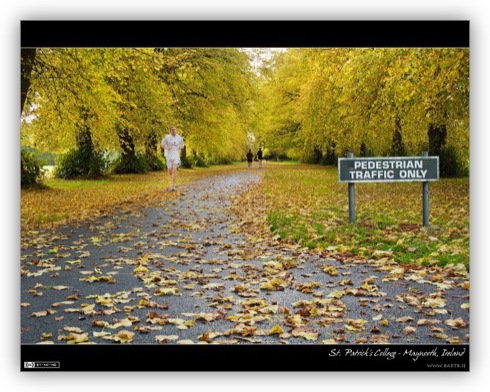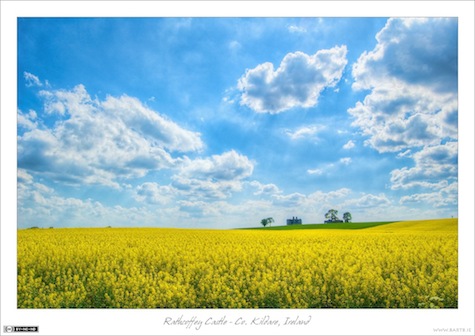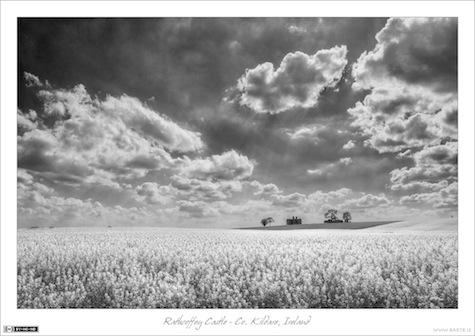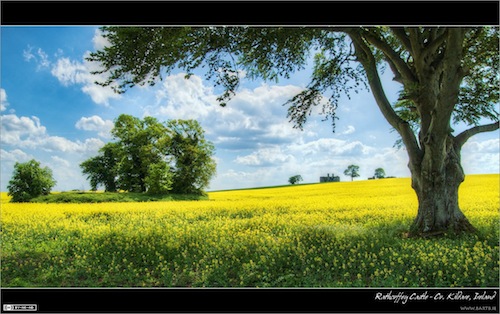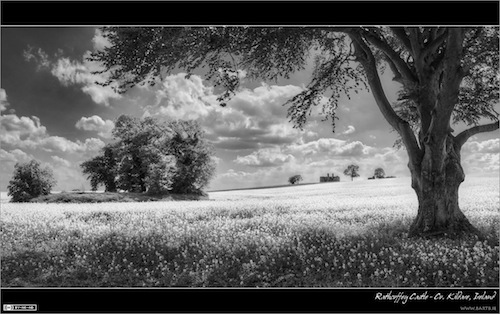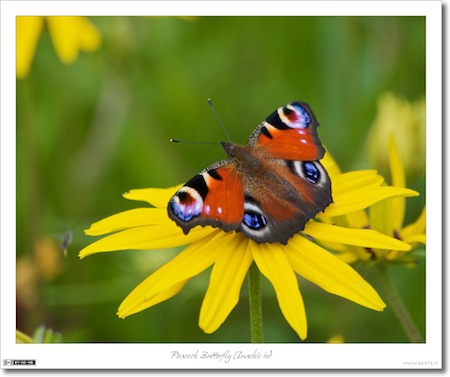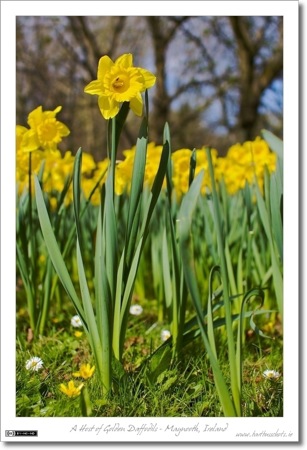Mar
27
Photo of the Week 163 – Jogging on the Graff
Filed Under Photography on March 27, 2011 | Leave a Comment
One of the things I really miss with all this being sick is spending my lunch times out and about enjoying the grounds of St. Patrick’s College, so I thought that this week I’d share one of my favourite shots of people enjoying those great grounds. As you can see from the photo – it’s “Pedestrian Traffic Only” along this lovely avenue of Linden trees, but that doesn’t mean it’s not busy 🙂
This general part of the college is known as ‘the Graff’ (technically I think the original Graff was one path to the North of this one) because it’s apparently as long as Graffton St. in Dublin city. Not sure how true it was, but when I worked as a tour guide for the Students’ Union during Freshers Week in the past that’s what was written on my script!
- Camera: Nikon D40
- Lens: Nikon DX AFS 18-55mm (D40 kit lens)
- Exposure: 1/100 sec
- Focal Length: 38mm
- Focal Ratio: f/8
- ISO: 400
- Camera Mode: Aperture Priority
- Exposure Bias: -0.67ev
Aug
2
Photo of the Week 127 & 128 – Big Summer Skies
Filed Under Photography on August 2, 2010 | Leave a Comment
I’ve been on a bit of a break from Photography – a combination of injury and crap-tacular weather, so I have yet another catch-up post to do! As always when I do multiple posts, the two images are related, in this case, very related, being two different treatments of the same RAW image. This shot was taken on the same day as the last monochrome-colour combo I posted (Photo of the Week 111 & 112 – Summer in Rathcoffey), and from a spot only a few hundred feet from where that last shot was taken.
Yesterday I posted some of my thoughts on Photographic composition, and used that post as the basis for a conversation with Allison on episode 271 of the Nosillacast podcast. In that discussion we talked about the importance of getting layers into photographs of places to give a sense of depth, and in particular we talked about the importance of the foreground layer. As part of that discussion I drew attention to the fact that there are a huge amount of possible foregrounds for every background. You can usually move hundreds of feet without making much, if any, change to the background when you’ve shooting landscapes. This gives you a wide menu of foregrounds to choose from.
If you compare and contrast these photos with those from my Photo of the Week 111 & 112 post, you’ll get a good example of just how different a shot you can get by just changing the foreground. Both sets of photos have Rathcoffey Castle as the background, both have the field of flowering Rape Seed flowers as the mid-ground, and both have the same dramatic sky at the top of the frame, but both have very different foregrounds, framings, and compositions, resulting very different photographs.
These shots have a far simpler composition, with far fewer elements in the frame. It really is just the field, the castle, and the sky. The previous shot was about showing the many interesting things around the edges of the field, the beautiful old tree, the ancient Ring Fort, and of course the castle, so it was composed in such a way as to show all these things without cluttering the frame. The filed and the sky were in that shot too, but they were almost incidental. Here, we have much less in the frame, so both the sky and the big sweeping field are the stars of the show, with the castle adding some nice interest to the background, but not being the star of the show.
These two sets of shots were taken very close to each other. The first a little to the left of the Ring Fort, with the Ring Fort included, the other a little to the right of the Ring Fort with it excluded. The Ring Fort is literally just a few pixels off to the right of this shot, but because you don’t see it, you assume it’s not there, and that the field goes on for ever. As it happens it really is a very big field, but doesn’t come across half as well in the shot if you include it’s edges.
As with the previous photos, this pair was generated using the workflow I described on the Typical Shutterbug Podcast.
- Camera: Nikon D40
- Lens: Nikon DX AFS 18-55mm (D40 kit lens)
- Exposure: 1/1250 sec
- Focal Length: 18mm
- Focal Ratio: f/8
- ISO: 200
- Camera Mode: Aperture Priority
- Processing: single RAW image first tonemapped with Photomatix Pro, then tweaked with the Topaz Adjust 4 plugin in Photoshop Elements
- Camera: Nikon D40
- Lens: Nikon DX AFS 18-55mm (D40 kit lens)
- Exposure: 1/1250 sec
- Focal Length: 18mm
- Focal Ratio: f/8
- ISO: 200
- Camera Mode: Aperture Priority
- Processing: single RAW image first tonemapped with Photomatix Pro, then tweaked with the Topaz Adjust 4 plugin in Photoshop Elements, and finally converted to monochrome using the Channel Mixer in Apeture
Jun
27
Photo of the Week 122 & 123 – Summer in Rathcoffey
Filed Under Photography on June 27, 2010 | 5 Comments
Last weekend the weather was just too good to sit inside working on a computer, so I didn’t find the time to post a photo of the week. This means we’re playing catch-up today with a double posting. As usual for a multiple post, I’ve chosen a theme to link the shots, in this case, both were generated from the same original RAW image from the camera!
Both shots show a wonderful view taken from a back road near Maynooth in Co. Kildare Ireland. The road is at the bottom of a sweeping hill at the top of which stand the ruins of Rathcoffey Castle. The farmer grows Rape Seed on the hill, so when that crop is in bloom, you get this amazing scene where the whole field is bright yellow, truly spectacular!
The fist shot I’m posting is the colour version, this is a panoramic crop, and was generated from a single RAW file by first tonemapping it with Photomatix Pro, and then tweaking the resulting image a little using the Topaz Adjust 4 plugin in Photoshop Elements. You might ask why the image needed to be tonemapped? The simple answer is that the difference in brightness between the land and sky were just too great to properly expose both in a single traditional exposure. Exposing either correctly would result in the other being badly under or over exposed. Tonemapping allows both to be properly exposed at the same time.
- Camera: Nikon D40
- Lens: Nikon DX AFS 18-55mm (D40 kit lens)
- Exposure: 1/800 sec
- Focal Length: 18mm
- Focal Ratio: f/8
- ISO: 200
- Camera Mode: Aperture Priority
The second shot was generating by using the first as a starting point, and then using the channel mixer to generate a monochrome version. The channel mixer allows you to choose how much of each colour goes into the black & white version of the image. By turning down the blue channel you can get stunning black skies which make for really dramatic photos.
- Camera: Nikon D40
- Lens: Nikon DX AFS 18-55mm (D40 kit lens)
- Exposure: 1/800 sec
- Focal Length: 18mm
- Focal Ratio: f/8
- ISO: 200
- Camera Mode: Aperture Priority
Feb
28
Photo of the Week 106 – Peacock Butterfly
Filed Under Photography on February 28, 2010 | 2 Comments
Since the butterfly season will be starting up again soon I’ve been having a look back at my butterfly shots from previous years to see what gaps there are in my collection to help me plan my priorities for this year. In the process I also picked a shot for this week’s Photo of the Week, one from last year that I’m immensely fond of.
This shot is of the Peacock Butterfly (Inachis io), the most colorful and spectacular species we have in Ireland. I got quite a few shots of this species throughout the year, and in previous years (including Photo of the Week 32), but I particularly like this one because of where the butterfly chose to land. To get a nice out of focus background you do need there to be a bit of a distance between your subject and the background, and you need the background to be fairly even. In this case the butterfly landed on a very tall and beautiful special of Daisy called Black0eyed Susan. Because the Black-eyed Susans are tall, the leaves of the other plants in the garden were a long way below, hence the lovely soft green bokeh. The lovely yellow flowers themselves also add a lot to the shot, and the red of the butterfly contrasts nicely with both the green and the yellow really making it stand out.
- Camera: Nikon D40
- Lens: Nikon DX AFS 55-200mm
- Exposure: 1/320 sec
- Focal Length: 200mm
- Focal Ratio: f/8
- ISO: 400
- Camera Mode: Aperture Priority
- Exposure Bias: -0.3ev
Apr
26
Photo of the Week 62 – A Host of Golden Daffodils
Filed Under Photography on April 26, 2009 | 1 Comment
I just love Daffodils, and each time I see a clump of them together the words of Wordswoth’s famous poem always spring to mind. As beautiful as a “host” of Daffodils is to look at, I’ve found it really difficult to capture that beauty well with my camera. After much experimentation, I finally got a shot I’m happy with by using a combination of a shallow depth of field, and a very low camera position. This way one Daffodil could be picked out from the crowd, while allowing the rest to form a lovely yellow and green bokeh. The reason for getting down low is to allow the one chosen Daffodil to be raised above the others in the frame, making it stand out even more than a shallow depth of field alone would allow.
- Camera: Nikon D40
- Lens: Sigma EX 30mm F1.4
- Exposure: 1/2500 sec
- Focal Length: 30mm
- Focal Ratio: F2.8
- ISO: 200
- Camera Mode: Aperture Priority







